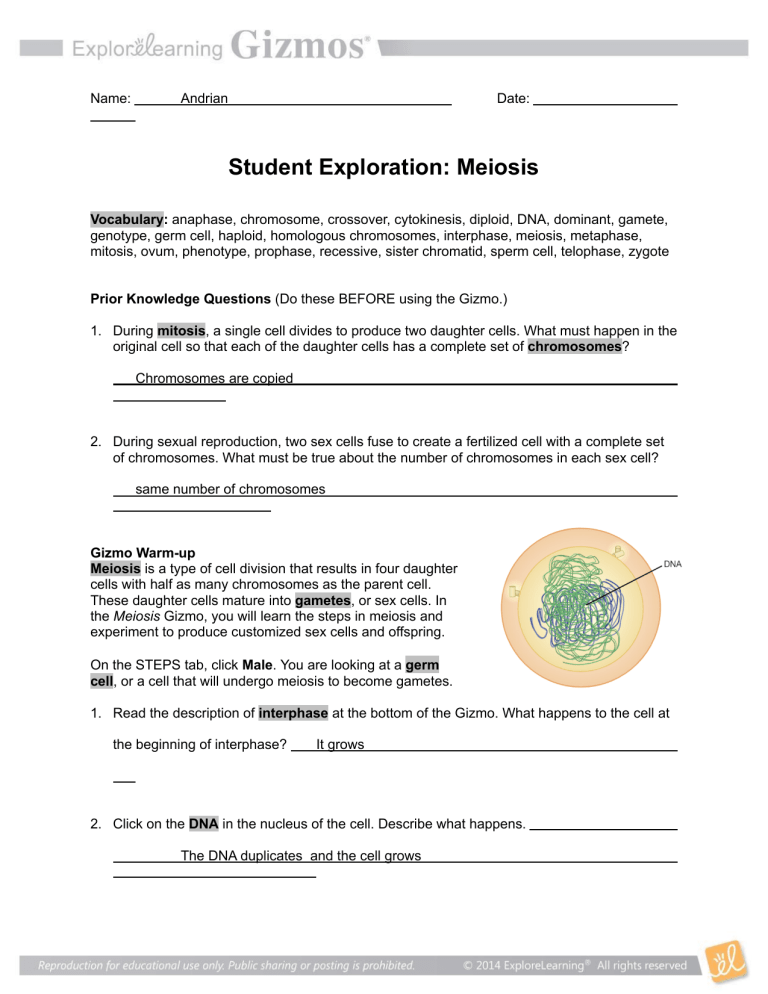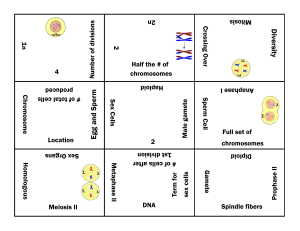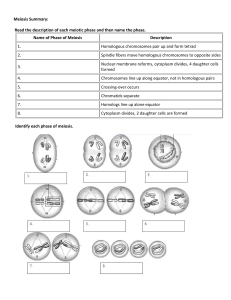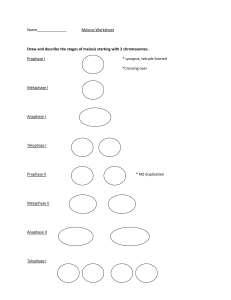
Name: Andrian Date: Student Exploration: Meiosis Vocabulary: anaphase, chromosome, crossover, cytokinesis, diploid, DNA, dominant, gamete, genotype, germ cell, haploid, homologous chromosomes, interphase, meiosis, metaphase, mitosis, ovum, phenotype, prophase, recessive, sister chromatid, sperm cell, telophase, zygote Prior Knowledge Questions (Do these BEFORE using the Gizmo.) 1. During mitosis, a single cell divides to produce two daughter cells. What must happen in the original cell so that each of the daughter cells has a complete set of chromosomes? Chromosomes are copied 2. During sexual reproduction, two sex cells fuse to create a fertilized cell with a complete set of chromosomes. What must be true about the number of chromosomes in each sex cell? same number of chromosomes Gizmo Warm-up Meiosis is a type of cell division that results in four daughter cells with half as many chromosomes as the parent cell. These daughter cells mature into gametes, or sex cells. In the Meiosis Gizmo, you will learn the steps in meiosis and experiment to produce customized sex cells and offspring. On the STEPS tab, click Male. You are looking at a germ cell, or a cell that will undergo meiosis to become gametes. 1. Read the description of interphase at the bottom of the Gizmo. What happens to the cell at the beginning of interphase? It grows 2. Click on the DNA in the nucleus of the cell. Describe what happens. The DNA duplicates and the cell grows 3. Why is it necessary for the cell to grow and duplicate its DNA before the start of meiosis? The daughter cells need the DNA. Activity A: Steps in meiosis Get the Gizmo ready: ● Make sure the STEPS tab is selected. ● If necessary, choose the Male cell. Click on the DNA to copy it to proceed to prophase I. Introduction: Unlike mitosis, which produces two identical daughter cells from one parent cell, meiosis creates four unique daughter cells with half the amount of DNA as the parent cell. Question: How does meiosis create four daughter cells from one parent cell? 1. Observe: (Prophase I) Click on the nucleus to break it down then click on the DNA to condense it into chromosomes. Drag the centrosomes to the top and bottom of the cell. A. How many chromosomes does this cell have? four Each chromosome consists of a pair of sister chromatids, two identical strands of DNA that formed when DNA replicated during interphase. B. On the image to the right, draw two lines connecting the pairs of homologous chromosomes (chromosomes of similar size with a matching set of genes). In the Gizmo, drag the homologous chromosomes together. Click Continue. 2. Observe: (Metaphase I and Anaphase I) - Drag the groups of homologous chromosomes to the metaphase plate, then drag spindle fibers from each of the centrosomes to the chromosomes. Click the centrosome to pull the chromosomes apart. How do the chromosomes separate in anaphase I? Homologous chromosomes are pulled apart to opposite end of the cell. Sister chromatids stay together. 3. Compare: An image of the anaphase step in mitosis is shown to the right. A. How does anaphase I in meiosis differ from anaphase in mitosis? it stays together B. At the end of anaphase I (meiosis), how many chromosomes are on each side? two (Activity A continued on next page) Activity A (continued from previous page) 4. Observe: Telophase I and cytokinesis are the final steps of the first half of meiosis. A. Describe what happens when you click on the chromosomes during telophase I. It results in the formation of two haploid daughter cells. B. Click and drag on the contractile ring. Describe what happened during cytokinesis. The ring shrinks, pinching the membrane inward and creating cleavage furrow. 5. Observe: Go through the steps of the second half of meiosis until you reach the end of telophase II, following the instructions at the top right corner. As you proceed, answer the questions below. Use the Back button if you need to see a step again. A. Before prophase II begins, does the DNA in the cell duplicate itself? no B. During metaphase II, do homologous chromosomes pair up as in metaphase I? no C. How does anaphase II differ from anaphase I? Sister chromatids stay together in Anaphase 1. D. At the end of anaphase II, how many chromatids are on each side of the cell? two E. After cytokinesis, how many cells have been formed from the parent cell? F. Are all of the cells the same size? four yes The original parent cell is called diploid because it contains a complete set of homologous chromosome pairs. Each of the four daughter cells is haploid, meaning that each contains half of the original parent cell’s chromosomes. Each daughter cell contains one chromatid from each homologous pair. 6. Observe: Click on the spermatids. Spermatids that formed from meiosis will develop into mature male gametes called sperm cells. Sketch a mature sperm cell in the space to the right. Mature sperm cells have only a small amount of cytoplasm and use their flagella, or “tails,” to propel themselves forward. Sperm are designed for one purpose, to deliver genetic material to the egg cell during fertilization. Activity B: Get the Gizmo ready: Comparing female and male gametes ● Make sure the STEPS tab is selected. ● Click Reset. Introduction: Although both male and female gametes contain genetic material from the parent organism, they perform different functions. A male gamete delivers genetic material to a female gamete. The fertilized female gamete, called a zygote, then grows into the offspring. Question: What are the differences in meiosis between male and female cells? 1. Compare: Click on the Female button. For the female cell, proceed through meiosis until you reach the end of anaphase I. Up to this point, did you notice any differences between the development of male and female gametes? no Explain. they have the same process 2. Compare: Proceed through telophase I and cytokinesis I. A. What do you notice about the size of the two resulting cells? than the rest one is bigger B. How does this compare to the two cells at the end of telophase I and cytokinesis I in male cells? The daughter cells in the male cell were the same size. 3. Compare: Continue through meiosis until you finish telophase II and cytokinesis II. A. What do you notice about the four cells now? B. What is the largest cell called? one is bigger than the rest ovum The ovum is the largest cell in the human body. In contrast, the sperm cell is the smallest cell in the human body. C. What are the small cells called? polar bodies Polar bodies are small cells that develop as a byproduct of meiosis in females. In humans and most other animals, these cells play no significant role and soon die. 4. Think and discuss: Why do you think egg cells are large and sperm cells are small? They contain many nutrients that are needed for the baby to grow and develop.




